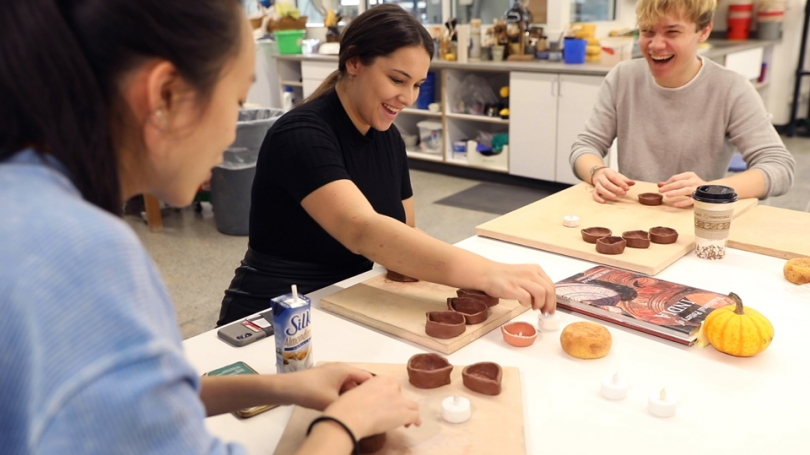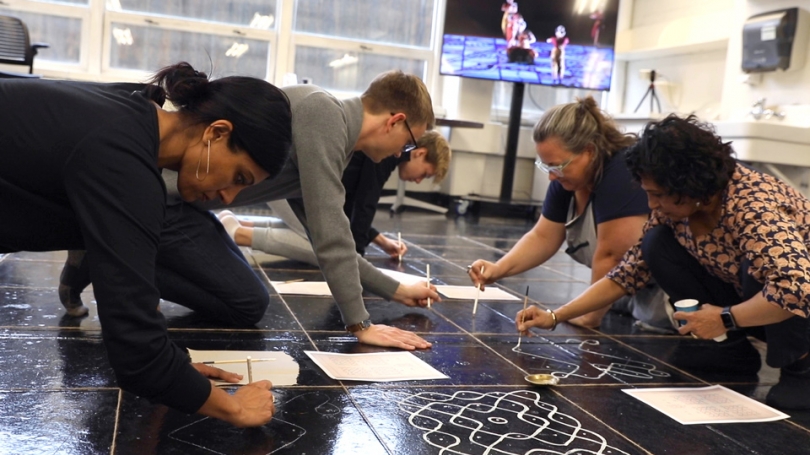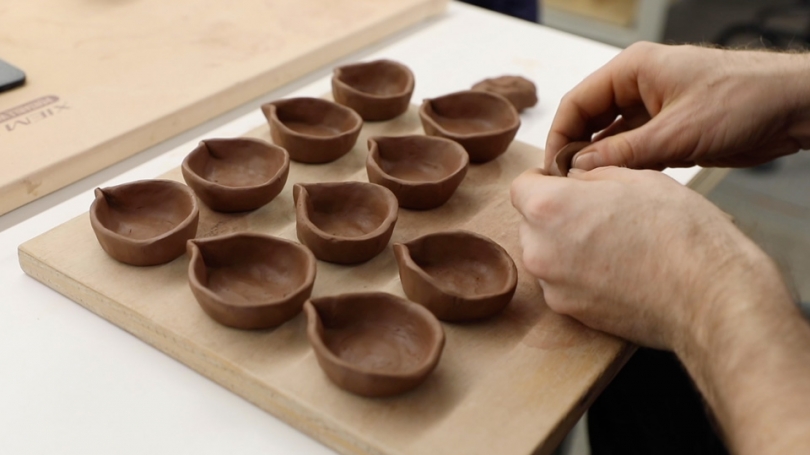Pinch pots, rice painting and reincarnation: Ragamala Dance Company visits the Hop
In late October, the mother and two daughters who lead Minneapolis-based Ragamala Dance Company led hands-on sessions in traditional Indian artforms associated with the end of life. The sessions will inform a work-in-progress the company will perform at the Hop in 2020. Hop Fellow Sam Fox gives us this first-person account.
The Ragamala Dance Company was founded in 1992 by Ranee Ramaswamy and is currently in its 26th season of touring. The company is headquartered in Minneapolis and run by mother (Ranee Ramaswamy) and her two daughters, Aparna and Ashwini. The group explores spirituality and their hybrid of American and Indian heritages through the Bharatanatyam style of dance. The company has performed in worldwide venues and has been recognized regionally by generous funding partnerships with arts foundations.
This fall, from October 26th to October October 29th, the Ragamala Dance Company were at Dartmouth for a residency where they workshopped their upcoming work, which will be touring at Dartmouth next year, titled The Fires of Varanasi. The work focuses on the holy site of Varanasi as a place of remembrance and respect for the dead, and thus deals with life, death, grief, memorialization and reincarnation. During the residency, the Ragamala Dance Company hosted multiple workshops in dance, ceramics and traditional Kolam painting and also engaged in conversations about their work at a School House dinner.
I had the privilege of attending both their ceramics and Kolam painting workshops, which were much more than simply learning how to recreate traditional Indian artforms. In the afternoon of Saturday 26th of October, the Ragamala Dance Company were busy teaching the art of making small pinch-pots in the ceramic studio. These pots were required for the art installation that they planned to create at the end of their residency. At the beginning of the workshop, Ranee, Aparna, and Ashwini introduced themselves to the participants. Together, they explained the importance of the small pinch pots that we were making which hold candles. Ranee explained how the clay, just like humans, is born from the earth and—once served its purpose—is taken back by the earth and reborn again into something completely new. Therefore, the pinch-pots are especially meaningful in events of memorialization.
As we crafted our pinch pots with care Ranee, Aparna, and Ashwini monitored the room to check on our progress. As they proctored the room, they introduced themselves personally and sparked up mini conversations about their culture, their religion, and the intersections between their American lives and Indian heritages. Aparna explained to me how in the Hindu tradition, candles are lit for the deceased in Varanasi every year after a member of the family has passed away to memorialize them, but how distance makes this practice difficult. To substitute for this practice, the members of the Ragamala Dance Company decided to create the performance, The Fires of Varanasi, as a meditation on what it means to memorialize the departed in a non-traditional yet respectful manner. As each of us talked about our cultures' memorialization practices, we began to realize how interconnected we are when it comes to mourning and respecting the dead. When the pinch-pots were done, Ranee, Aparna, and Ashwini invited us to their next workshop held the following day, where we would be practicing the art of Kolam making.
The following day I attended the Kolam painting workshop, which constituted the second leg of their art installation. Ranee explained that Kolams are floor drawings made from flour and water which are used for ceremonial designs to harbor good fortune. Going more in-depth, Ranee described how the Kolams are drawn outside of one's house to protect the people inside and are traditionally done by women before sunrise to bring luck into the day. While there are many different Kolam designs, Ranee taught us several of the basics before showing us how skilled she was in the art. After laughing off the compliments we all gave her, Ranee confessed that she'd been creating Kolams since the age of five, when she lived with her grandmother and pregnant mother in India. While she warned us that Kolam painting took time and dedication to perfect, she encouraged us to try filling the room's floor with the beautiful patterns she had taught us. After some quick practice-runs with paper and pencil, we were ready to try the real-deal with a rice flour and water mixture painted on the floor.
As Ranee, Aparna, and Ashwini's pervious performances played therapeutically on the TV in the background, we all entered the meditative state required to perfect Kolam painting. A peaceful silence fell over the room as concentration took over. I created two unique Kolam designs before my legs started to feel numb from leaning on the hard floor, to which Ranee replied with sarcasm: "You're young! I've been doing this for years and I'm fine!" She was right, but she accepted that her experience in crafting Kolams since the age of five put her at an advantage. When we finished painting, Aparna told us that the pinch-pots crafter yesterday would be placed in the middle of each Kolam to finish the art installation, and that the Residency will then have fulfilled its purpose. When I stopped by to see the finished installation a few days later, it was beautiful.
In my two days spent with the Ragamala Dance Company, I learned not only how to create Kolams and pinch-pots, but I also learned about a rich cultural and religious practice of memorializing the deceased that I was not previously privy to. Getting to know Ranee, Aparna, and Ashwini through the sharing of their culture and heritage was a true honor. It is to my great sadness as a senior that the Ragamala Dance Company will not be returning to perform until after I graduate, but having spent last weekend in their company, I am sure that The Fires of Varanasi will be an unmissable and spellbinding performance that encapsulates not only the wonderful performers' personalities but indeed the culturally rich translation of death ritual and memorialization from words into the language of movement and dance.


